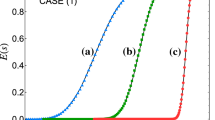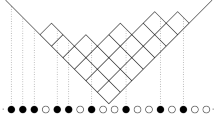Abstract
We study the scaling limit of the spectrum of the β-Jacobi ensemble at the soft edge and hard edge for general values of β. We show that the limiting point processes correspond respectively to the stochastic Airy and Bessel point processes introduced in Ramírez et al. (J. Am. Math. Soc. 24(4):919–944, 2011) and Ramírez and Rider (Commun. Math. Phys. 288(3):887–906, 2009).
Similar content being viewed by others
References
Bloemendal, A., Virag, B.: Limit of spiked random matrices I. arXiv:1011.1877v2 (2010)
Bourgade, P., Erdos, L., Yau, H.T.: Universality of general β-ensembles. arXiv:1104.2272v5 (2011)
Capitaine, M., Casalis, M.: Asymptotic freeness by generalized moments for Gaussian and Wishart matrices. Indiana Univ. Math. J. 53, 397–432 (2004)
Collins, B.: Product of random projections, Jacobi ensembles and universality problems arising from free probability. Probab. Theory Relat. Fields 133, 315–344 (2005)
Dumitriu, I.: Smallest eigenvalue distributions for two classes of β-Jacobi ensembles. arXiv:1009.4677 [math.PR] (2010)
Dumitriu, I., Edelman, A.: Matrix models for beta ensembles. J. Math. Phys. 43(11), 5830–5847 (2002)
Dumitriu, I., Forrester, J.: Tridiagonal realization of the anti-symmetric Gaussian β-ensemble. J. Math. Phys. 51(9), 093302 (2010)
Dumitriu, I., Koev, P.: Distribution of the extreme eigenvalues of the Beta-Jacobi random matrix model. SIAM J. Matrix Anal. Appl. 30, 1–6 (2008)
Dette, H., Nagel, J.: Some asymptotic properties of the spectrum of the Jacobi ensemble. SIAM J. Math. Anal. 41(4), 1491–1507 (2009)
Ethier, S.N., Kurtz, T.: Markov Processes. Characterization and Convergence. Wiley, New York (1988)
Edelman, A., Sutton, B.: From random matrices to stochastic operators. J. Stat. Phys. 127(6), 1121–1165 (2007)
Jacquot, S., Valko, B.: Bulk scaling limit of the Laguerre ensemble. Electron. J. Probab. 16(11), 314–346 (2011)
Jiang, T.: Limit theorems for Beta-Jacobi ensembles. arXiv:0911.2262 (2009)
Johnstone, I.: Multivariate analysis and Jacobi ensembles: largest eigenvalue, Tracy-Widom limits and rates of convergence. Ann. Stat. 36(6), 2638–2716 (2008)
Killip, R., Nenciu, I.: Matrix models for circular ensembles. Int. Math. Res. Not. 2004(50), 2665–2701 (2004)
Mehta, M.L.: Random Matrices. Elsevier/Academic Press, Amsterdam (2004)
Nagao, T., Forrester, P.: Asymptotic correlations at the spectrum edge of random matrices. Nucl. Phys. B 435, 401–420 (1995)
Nagao, T., Wadati, M.: Eigenvalue distribution of Random Matrices at the spectrum edge. J. Phys. Soc. Jpn. 62, 3845–3856 (1993)
Ramírez, J., Rider, B., Virág, B.: Beta ensembles, stochastic Airy spectrum, and a diffusion. J. Am. Math. Soc. 24(4), 919–944 (2011)
Ramírez, J., Rider, B.: Diffusion at the random matrix hard edge. Commun. Math. Phys. 288(3), 887–906 (2009)
Sutton, B.: The stochastic operator approach to random matrix theory. PhD thesis, Massachusetts Institute of Technology (2005)
Tracy, C., Widom, H.: Level spacing distributions and the Airy kernel. Commun. Math. Phys. 159(1), 151–174 (1994)
Tracy, C., Widom, H.: Level spacing distributions and the Bessel kernel. Commun. Math. Phys. 161(2), 289–309 (1994)
Valkó, B., Virág, B.: Continuum limits of random matrices and the Brownian carousel. Invent. Math. 177(3), 463–508 (2009)
Wishart, J.: The generalised product moment distribution in samples from a normal multivariate population. Biometrika 20A(1–2), 32–52 (1928)
Acknowledgements
The authors would like to thank Benedek Valkó for introducing them to the field of random matrices and suggesting this problem. We also thank the referees for their valuable comments.
Author information
Authors and Affiliations
Corresponding author
Appendix: Proof of Theorem 2
Appendix: Proof of Theorem 2
We will be working primarily with a lower bidiagonal matrix M, and the symmetric tridiagonal matrix MM T. For convenience we will adopt the following notations. Denote the diagonal entries of our symmetric tridiagonal matrix MM T by \(\underline {a}= \{a_{1},\ldots,a_{n}\}\) and its off-diagonal entries by \(\underline {b}=\{b_{1},\ldots, b_{n-1} \}\). For the entries of the bi-diagonal matrix M use \(\underline {x}= \{x_{1},\ldots,x_{n}\}\) to denote the diagonal entries and \(\underline {y}=\{ y_{1},\ldots,y_{n-1} \}\) for its sub-diagonal entries. We will also use another tridiagonal matrix which arises in the following lemma (see e.g. [7]):
Lemma 23
Let M be an n×n bidiagonal matrix with a 1,a 2,…,a n in the diagonal and b 1,b 2,…,b n−1 in the off-diagonal. Consider the 2n×2n symmetric tridiagonal matrix L which has zeros in the main diagonal and a 1,b 1,a 2,b 2,…,a n above and below the diagonal. If the singular values of M are λ 1,λ 2,…,λ n then the eigenvalues of L are ±λ i ,i=1…n.
Recall the definitions of M β,n ,C k and \(\tilde{C}_{k}\) from the statement of Theorem 2. It will be convenient write \(\{C_{i},S_{i}\}_{i=1}^{n}\) and \(\{\tilde{C}_{i}, \tilde{S}_{i}\}_{i=1}^{n-1}\) in terms of a set of random angles \(\underline {\alpha }= \{ \alpha_{1}, \ldots, \alpha_{n} \}\) and \(\underline {\theta }=\{\theta_{1},\ldots, \theta_{n-1}\}\) where C k =cos(α k ) and \(\tilde{C}_{k} = \cos(\theta_{k})\). Then, S k =sin(α k ) and \(\tilde{S}_{k} = \sin(\theta_{k})\), and the densities of the random angles α k and θ k are:

with a,b defined as in Theorem 2 and B(x,y) the beta function. By independence, the joint density of \((\underline {\alpha }, \underline {\theta })\) is given by the product of the densities. For convenience we will denote
This will be the necessary normalizing constant.
We will now map \((\underline {\alpha }, \underline {\theta })\) to the entries of M and from there to \((\underline {\lambda }, \underline {q})\) where the λ i are the eigenvalues of MM T and the q i are the positive leading entries of the corresponding normalized eigenvectors. This second map will actually by the composition of several maps.
From the angles we map to the entries of the bidiagonal matrix:
Lemma 24
The Jacobian of the transform \(T:(\underline {\alpha }, \underline {\theta }) \to (\underline {x}, \underline {y})\), where

(for notational convenience we take θ n =π/2) is given by

Proof
The matrix of the partial derivatives with ordering (α 1,…,α n ,θ 1,…,θ n−1)→(x 1,…,x n ,y 1,…,y n−1) has diagonal entries
Row and column reduction gives us that the determinant is given by the product of the diagonal, therefore
□
We finish by mapping from the bidiagonal to the tridiagonal matrix, which in turn is mapped to by the eigenvalues. Denote by q 1,…,q n the leading entries of the eigenvectors associated with the ordered eigenvalues λ 1<λ 2<⋯<λ n of the tridiagonal matrix normalized so that q i >0 and \(\sum q_{i}^{2} =1\).
Lemma 25
([6], Lemmas 2.7, 2.9 and 2.11)
For \(\underline {x},\underline {y},\underline {a},\underline {b},\underline {\lambda }\) and \(\underline {q}\) defined as above we have the following:
-
(1)
The Jacobian of the map \(\psi: (\underline {x}, \underline {y}) \to(\underline {a}, \underline {b})\) can be written as
$$J_\psi= 2^n x_1 \prod _{i=2}^{n} x_i^2. $$ -
(2)
The Vandermonde determinant for the ordered eigvenvalues of a symmetric tridiagonal matrix with positive sub-diagonal b=(b n−1,…,b 1) is given by
$$\Delta( \underline {\lambda })= \prod_{i<j}( \lambda_i-\lambda_j)= \frac{\prod_{i=1}^{n-1} b_i^i}{\prod_{i=1}^n q_i}. $$ -
(3)
The Jacobian of the map \(\phi:(\underline {a}, \underline {b}) \to(\underline {\lambda }, \underline {q})\) can be written as
$$J_\phi= \frac{\prod_{i=1}^{n-1} b_i}{\prod_{i=1}^n q_i}. $$
Written in terms of our \(\underline {x}, \underline {y}, \underline {a}\), and \(\underline {b}\) with \(Q_{n}= \prod_{i=1}^{n} q_{i}\) we get

The remainder of the proof of Theorem 2, is to show that the Jacobian of the transformation gives the desired result.

We substitute in the following pieces: first, notice that
Then, applying Lemma 23, the singular values of M n,β are the squares of the eigenvalues of the symmetric tridiagonal matrix L with zeroes in the main diagonal and
in the off-diagonal. We can check that L+I can be written as AA T where A is the bidiagonal matrix with
in the diagonal and below the diagonal respectively. Using the characterization from Lemma 23, we find that
Remark 26
At this point one could again apply Lemma 23 to A to find a 4n×4n matrix with zeros in the diagonal and
above and below the diagonal. This matrix will have eigenvalue \(\pm \sqrt{1\pm\sqrt{\lambda_{k}}}\).
Lastly recall ([6], Lemma 2.7) that we have
Making all the appropriate substitutions this gives us that

From this we can see that the joint density function of \(\underline {q}\) and \(\underline {\lambda }\) separate. As in the Hermite and Laguerre cases we have that \(\underline {q}\sim( \chi_{\beta},\ldots,\chi_{\beta})\) normalized to unit length [6]. This give us that for the unordered eigenvalues
This completes the proof of Theorem 2. □
Remark 27
The normalizing constant on the final density can be written as
This gives an alternate derivation for the Selberg integral.
Rights and permissions
About this article
Cite this article
Holcomb, D., Moreno Flores, G.R. Edge Scaling of the β-Jacobi Ensemble. J Stat Phys 149, 1136–1160 (2012). https://doi.org/10.1007/s10955-012-0634-3
Received:
Accepted:
Published:
Issue Date:
DOI: https://doi.org/10.1007/s10955-012-0634-3




